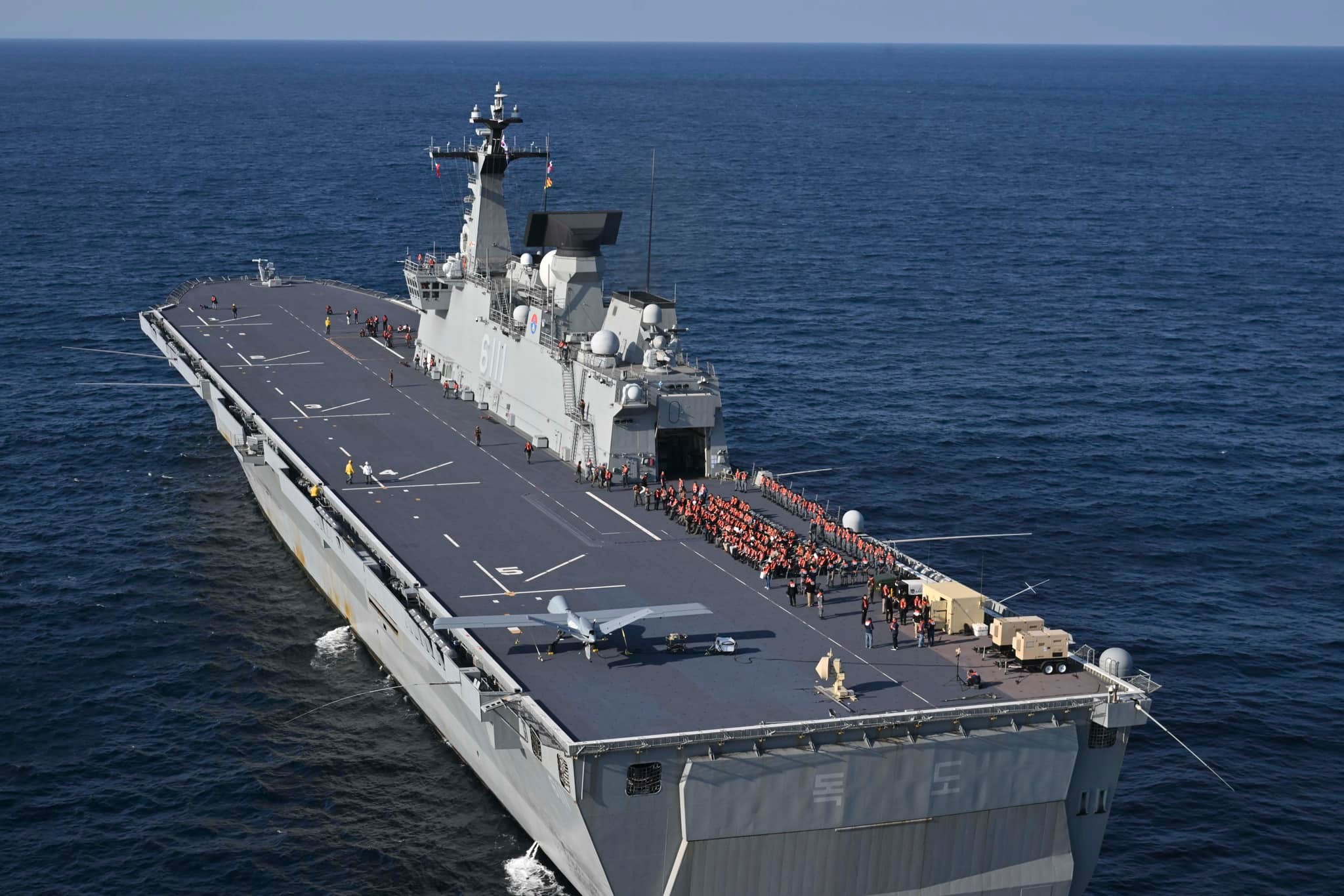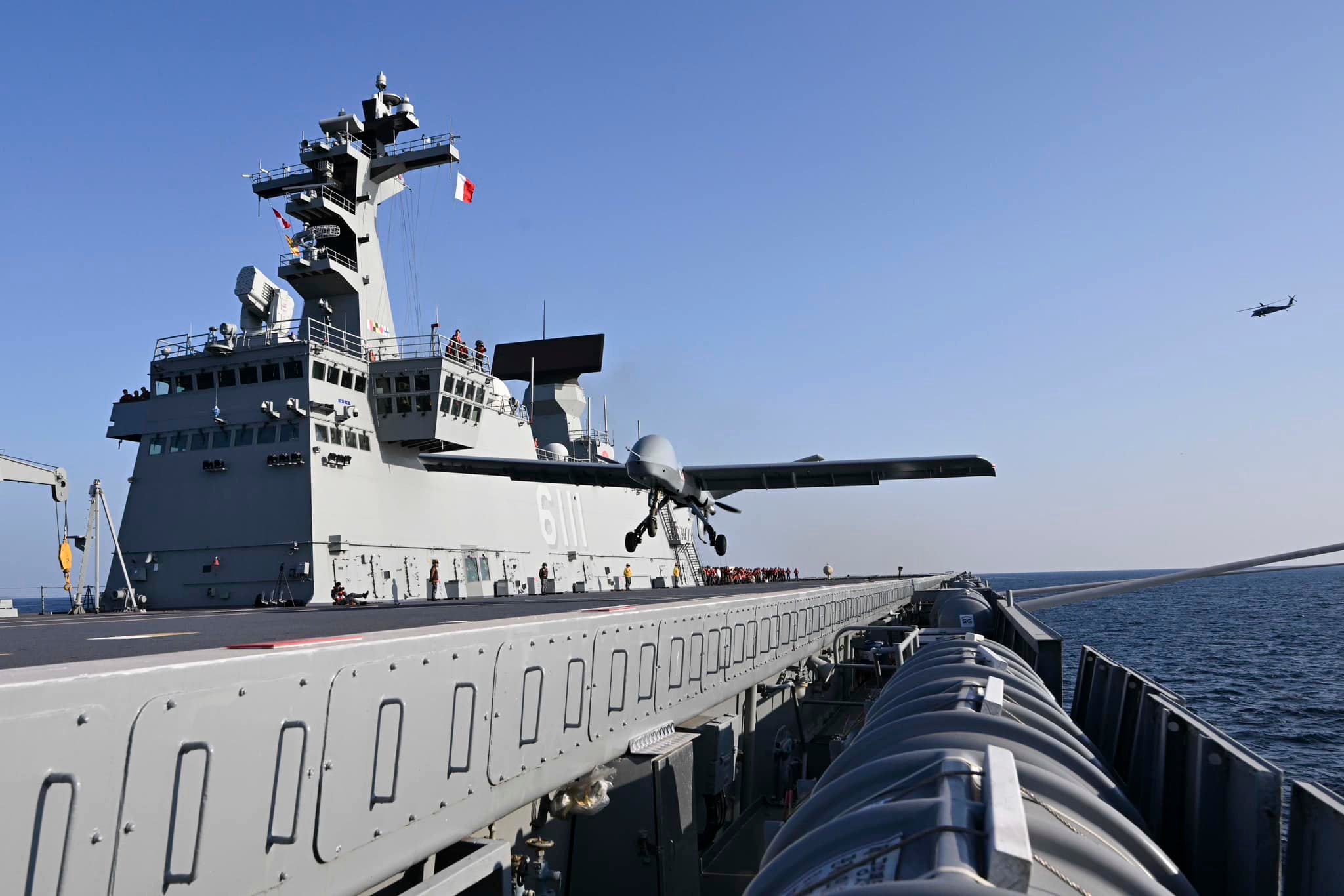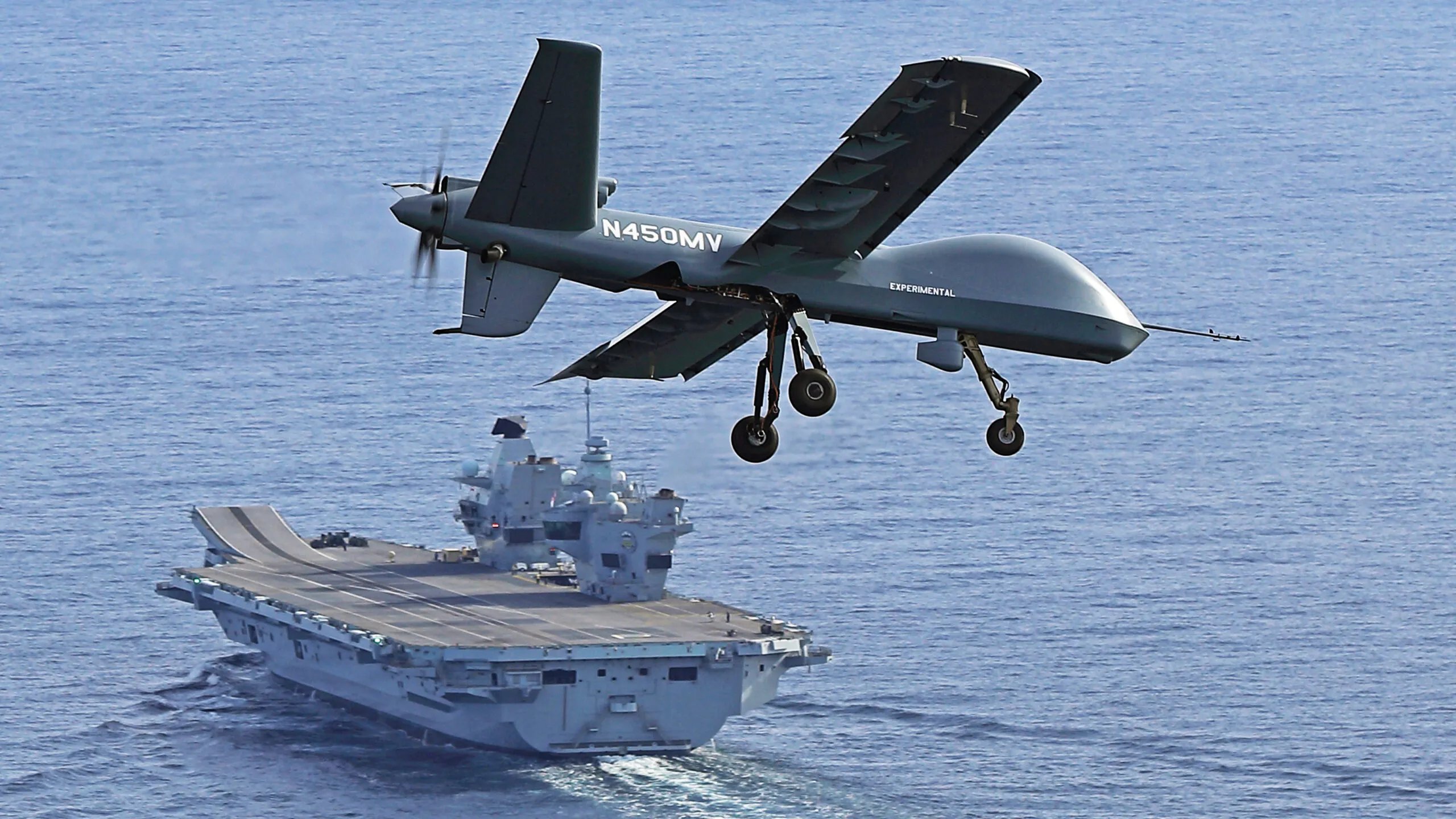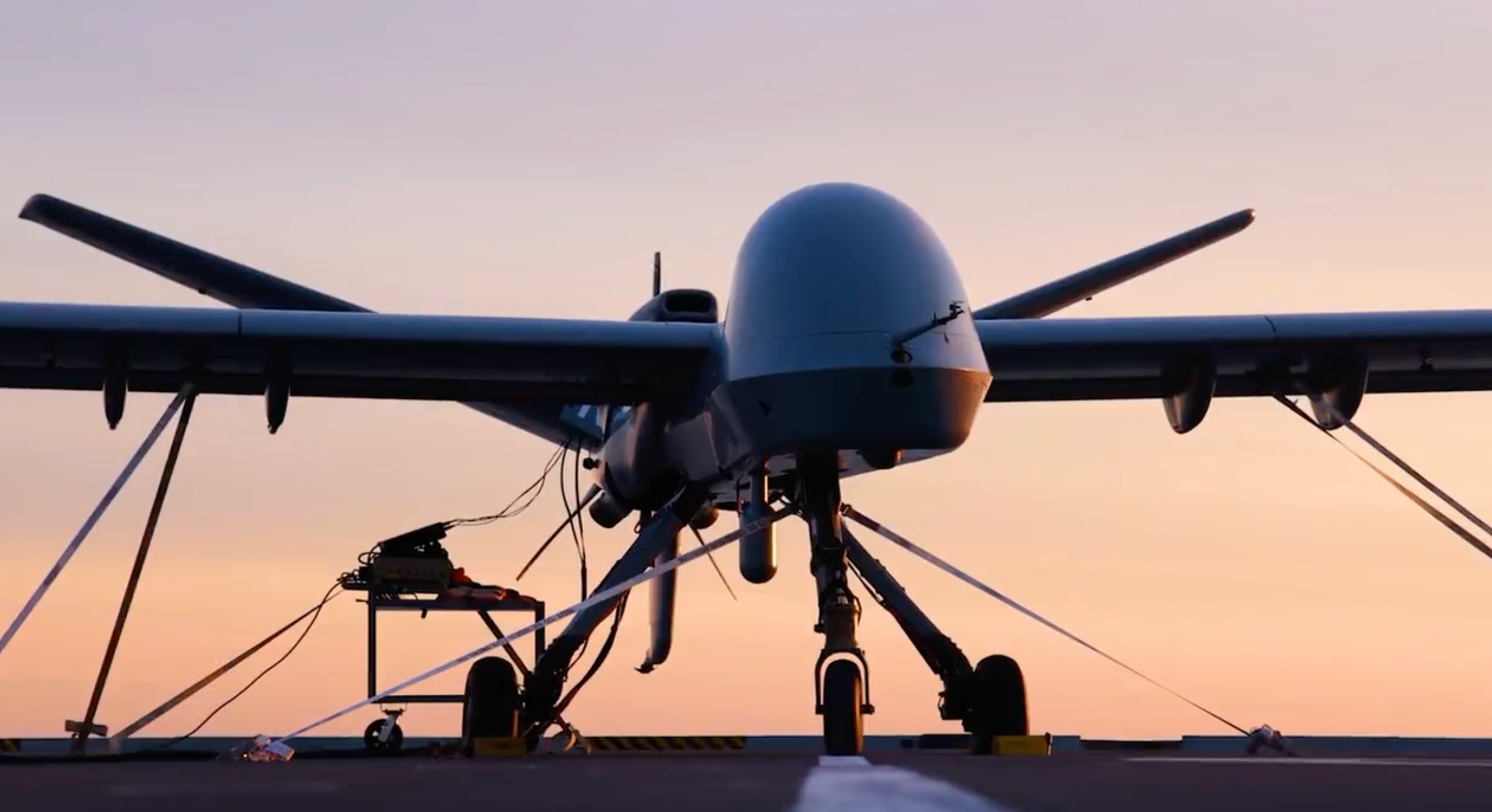The General Atomics Aeronautical Systems (GA-ASI) Gray Eagle STOL drone has undertaken its first experimental operations from a warship, taking off from the deck of the South Korean amphibious assault ship Dokdo. The Gray Eagle STOL — a design we have discussed in depth in the past — incorporates technology first demonstrated on the company’s Mojave, which was specifically developed with the ability to perform short takeoffs and landings, including from rough fields, with minimal support. The latest development adds to the aviation-capable warships that the wider family of Q-1 lineage drones have now operated from.
The Republic of Korea Navy (ROKN) confirmed the test took place yesterday, November 12, in the East Sea — the South Korean name for the Sea of Japan. Officials confirmed that this was the first time that a fixed-wing drone of any kind operated from an ROKN vessel.
The Gray Eagle STOL drone came aboard the Dokdo disassembled, was then reassembled and tested for a week, before taking off from the deck of the vessel. The drone flew for roughly one hour, before landing at a Naval Air Command facility in Pohang, around 170 miles southeast of Seoul. The ROKN said that communications were maintained between the drone, the warship, and the Naval Air Command, although it’s unclear where the control station for the drone was located. As far as we know, the drone did not land on the Dokdo at any point in the trials.


The Gray Eagle STOL used in the trials very clearly carries the U.S. civilian registration N450MV, indicating that it’s the same airframe as the original Mojave demonstrator, modified to the latest standard, or at the very least given a new coat of paint. As GA-ASI puts it, “Gray Eagle STOL is General Atomics’ name for the production variant of the historic aircraft demonstrator known as Mojave” — but it remains unclear what, if any, changes have been made to the actual aircraft.

The Dokdo class appear to provide a suitable platform for exploring operations by fixed-wing drones — and could potentially field them on a permanent or regular basis in the future.
The Dokdo class LPH is 652 feet long, 101 feet wide, and has a displacement of 19,500 tons.

As it stands now, the Dokdos are configured to carry a complement of around 10 medium-lift helicopters, such as the ROKN’s UH-60P Black Hawks or Leonardo AW159 Wildcats.
In the past, South Korea looked at using the Dokdo class design as a springboard to develop a true fixed-wing capable aircraft carrier that can embark F-35B short takeoff and vertical landing (STOVL) stealth fighters. More recently, those plans — for the so-called CVX — were dramatically scaled back, with Seoul instead choosing to invest in its increasingly capable submarine fleet.

These changing priorities may well have helped generate interest in fixed-wing drone operations, instead.
In the process, GA-ASI is gaining more experience in operating its Gray Eagle STOL and related Mojave from the decks of different warships.
Almost exactly a year ago, TWZ reported on the experimental operations involving the Mojave aboard the U.K. Royal Navy’s HMS Prince of Wales, the first time the drone had operated from an aircraft carrier. For its part, the Royal Navy is increasingly looking to harness the capability offered by uncrewed aircraft for its carrier force.

With a 901-foot-long flight deck, HMS Prince of Wales (and its sister vessel HMS Queen Elizabeth) offers more ‘real estate’ for Gray Eagle STOL operations than the Dokdo class, which has a flight deck length of just under 653 feet.
Unlike the Gray Eagle STOL trials on the Dokdo, the Mojave demonstration on HMS Prince of Wales involved a takeoff and a landing.
The dimensions of the Dokdo may well put some limits on Gray Eagle STOL’s load-carrying capability. While we don’t have the figures for Gray Eagle STOL, according to GA-ASI, the Mojave has a takeoff run of 1,000 feet when armed with 12 AGM-114 Hellfire air-to-surface missiles. However, when configured for intelligence, surveillance, and reconnaissance (ISR) missions, the Mojave’s takeoff distance is reduced to just 400 feet. Provided the figure is broadly the same for Gray Eagle STOL, this would be ample when operating off from the South Korean warship. The addition of an electromagnetic catapult on big deck amphibious assault ships, which is of rising interest with navies around the globe, could potentially allow an aircraft like Gray Eagle STOL to operate at higher gross weights from their decks.

When the Mojave was first unveiled, GA-ASI pointed out that its improved short-field performance and rugged landing gear would also make it suitable for carrier-based operations. What’s more, these can be conducted without any need for a catapult to launch the drone or arresting gear during recovery. The same characteristics have now been ported over to the Gray Eagle STOL.
At the same time, the Gray Eagle STOL adds new features that were not found on the Mojave, including the various technologies introduced on the improved Gray Eagle 25M. This drone was developed to provide the U.S. Army with the option to procure a more advanced version of the MQ-1C Gray Eagle, with various enhancements specifically designed to better meet the demands of a future conflict with a peer or near-peer state.

The new features on the Gray Eagle 25M — now found on the Gray Eagle STOL — include an improved heavy-fuel engine, increased onboard power, significantly reduced maintenance requirements, and an expeditionary laptop-based ground control station.
In our previous coverage of the Mojave, we discussed how the drone would likely be suitable for use not only from aircraft carriers like the Queen Elizabeth class, but also from large assault ships without launch and recovery gear like the Dokdo class — not to mention the U.S. Navy’s America class landing helicopter assault (LHA) and Wasp class landing helicopter dock (LHD) ships. The same applies to the Gray Eagle STOL.

Maritime missions for the Gray Eagle STOL or the Mojave could include overwatch of the amphibious assault task group, including the beachhead, or overwatch during force protection missions in ‘brown water’ or littoral environments. Carrying surveillance equipment, the drones could also expand the reach of the Dokdo class during anti-submarine warfare operations, making good use of the unarmed Mojave’s endurance of between 10 and 12 hours when launched off a carrier-sized landing area with no weapons.
Since the Gray Eagle STOL and the Mojave can also be armed, these missions could be extended to persistent armed overwatch, or even strike, including close air support of an amphibious assault, for example. Moreover, having armed drones would bring an entirely new fixed-wing combat capability to the Dokdo class, which currently relies on helicopters to provide extended anti-surface and anti-submarine warfare capabilities.

When operating in ‘blue water’ environments, these types of drones could also prove very valuable as networking and communications relay nodes, as well as acting as electronic warfare platforms, and even for airborne early warning. Overall, a MALE drone offers a set of capabilities that a helicopter simply can’t replicate. With their short range, helicopters cannot maintain a presence for many hours at a time, at extended ranges from the ship, or at the kinds of elevated altitudes that these kinds of drones can. These attributes translate to far superior line-of-sight performance and endurance, which would further free the host warship from relying on land-based assets and provide them with much improved organic capabilities.
South Korea’s Yonhap news agency described yesterday’s test as part of wider “efforts to better integrate and improve operations of manned and unmanned military equipment” within the Republic of Korea Armed Forces.
While the plans to fly the Gray Eagle STOL from the Dokdo class landing platform helicopter (LPH) — two of which are in ROKN service — had not previously been publicized, South Korea’s efforts to introduce drones of various classes and types is significant.

The Republic of Korea Armed Forces already operates a wide range of drones, ranging in size from Israeli-made Harpy loitering munitions to U.S.-supplied RQ-4B Block 30 Global Hawk high-altitude, long-endurance, remotely piloted aircraft.
Locally developed drone programs include the Korean Unmanned System – Fixed-wing Strategic (KUS-FS) medium-altitude, long-endurance drone, broadly similar to the U.S. MQ-9 Reaper, and the Korean Unmanned System – Vertical Helicopter (KUS-VH), an uncrewed armed scout adaptation of the MD500 helicopter, and therefore equivalent to the Unmanned Little Bird developed by Boeing.
In the future, South Korea plans to field drones to complement the KF-21 Boramae next-generation combat aircraft, as a means of boosting the potential of the crewed fighter as well as maximizing ‘combat mass.’ You can read more about the concept here. Last year, South Korea showcased a new stealthy-shaped flying wing drone, apparently intended to test technologies that could feed into ‘loyal wingman’ efforts as well as drones for potentially a wide range of other tasks.

So far, however, drone activities by the ROKN have been more limited. Acquisitions have included the popular Schiebel CAMCOPTER S-300 unmanned air system (UAS), a small rotary-wing drone that can operate from the flight decks of even small warships.

At this stage, we have little idea of Seoul’s ambitions in terms of fixed-wing drone operations from the Dokdo class — or even future amphibious assault ships. Perhaps more importantly, at least in the short term, the trials aboard the Dokdo have further underscored the ability of both the Gray Eagle STOL and the Mojave to operate from ships of this size, something that is likely to be of interest to operators of other aircraft carriers and amphibious assault ships, even without launch and recovery gear.
Contact the author: thomas@thewarzone.com
